KIA Sedona 2018 Owners Manual
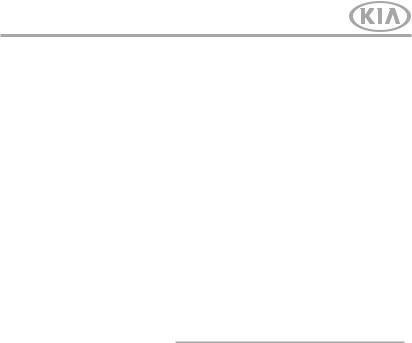
Kia, THE COMPANY
Thank you for becoming the owner of a new Kia vehicle.
As a global car manufacturer focused on building high-quality vehicles with exceptional value, Kia Motors is dedicated to providing you with a customer service experience that exceeds your expectations.
All information contained in this Owner’s Manual was accurate at the time of publication. However, Kia reserves the right to make changes at any time so that our policy of continual product improvement can be carried out.
This manual applies to all models of this vehicle and includes descriptions and explanations of optional as well as standard equipment. As a result, you may encounter material in this manual that is not applicable to your specific Kia vehicle.
Drive safely and enjoy your Kia! 
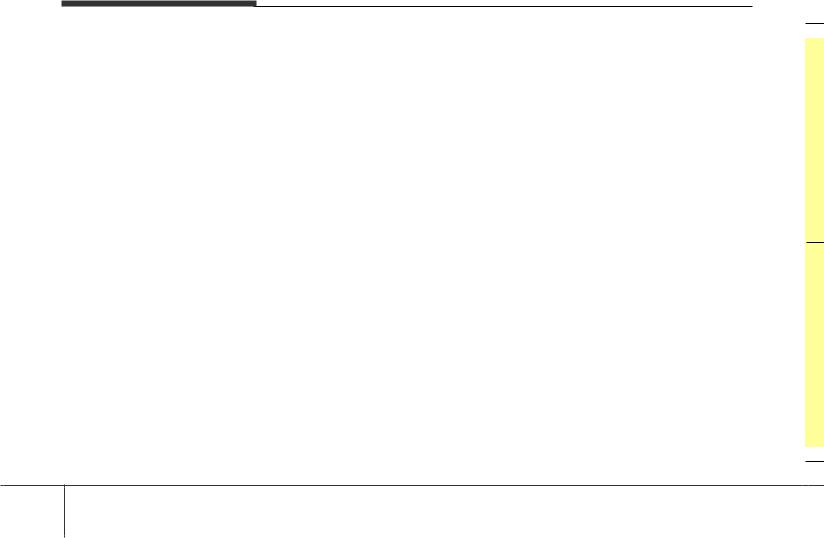
F o r e w o r d
Thank you for choosing a Kia vehicle.
When you require service, remember that your Kia dealer knows your vehicle best. Your dealer has factory-trained technicians, recommended special tools and genuine Kia replacement parts. It is dedicated to your complete customer satisfaction.
Because subsequent owners require this important information as well, this publication should remain with the vehicle if it is sold.
This manual will familiarize you with operational, maintenance and safety information about your new vehicle. It is supplemented by a Warranty and Consumer Information manual that provides important information on all warranties regarding your vehicle.
We urge you to read these publications carefully and follow the recommendations to help assure enjoyable and safe operation of your new vehicle.
Kia offers a great variety of options, components and features for its various models. Therefore, some of the equipment described in this manual, along with the various illustrations, may not be applicable to your particular vehicle.
The information and specifications provided in this manual were accurate at the time of printing. Kia reserves the right to discontinue or change specifications or design at any time without notice and without incurring any obligation. If you have questions, always check with your Kia dealer.
We assure you of our continuing interest in your motoring pleasure and satisfaction in your Kia vehicle.
© 2017 Kia Canada Inc.
All rights reserved. Reproduction by any means, electronic or mechanical, including photocopying, recording, or by any information storage and retrieval system or translation in whole or part is not permitted without written authorization from Kia Canada Inc..
Printed in Korea
i

Introduction |
|
1 |
|
|
|
|
|
|
Your vehicle at a glance |
|
2 |
|
|
|
|
|
|
Safety features of your vehicle |
|
3 |
|
|
|
|
|
|
Features of your vehicle |
|
4 |
|
|
|
table of contents 
Driving your vehicle |
|
5 |
|
|
|
|
|
|
What to do in an emergency |
|
6 |
|
|
|
|
|
|
Maintenance |
|
7 |
|
|
|
|
|
|
Specifications & Consumer information |
|
8 |
|
|
|
|
|
|
Index |
|
I |
|
|
|
ii

Introduction
. . . . . . . . . . . . . . . . . . . . . .How to use this manual |
1-2 |
1 |
Fuel requirements . . . . . . . . . . . . . . . . . . . . . . . . . . |
1-3 |
|
|
• Gasoline containing alcohol and methanol. . . . . . . . . 1-3
• Do not use methanol . . . . . . . . . . . . . . . . . . . . . . . . . . . 1-5
• Fuel Additives . . . . . . . . . . . . . . . . . . . . . . . . . . . . . . . . 1-5
• Operation in foreign countries. . . . . . . . . . . . . . . . . . . 1-6
Vehicle handling instructions . . . . . . . . . . . . . . . . . 1-6 Vehicle break-in process . . . . . . . . . . . . . . . . . . . . . 1-6 Vehicle data collection and event data recorders. . . 1-7
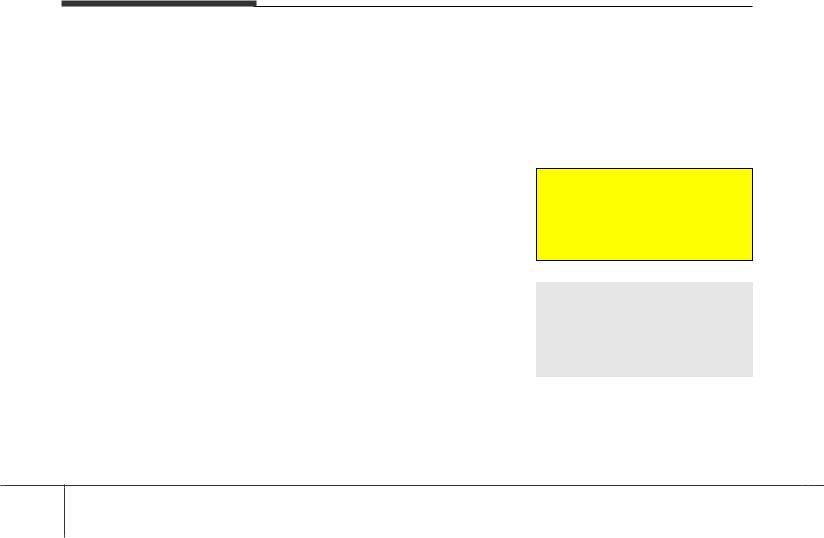
Introduction
HOW TO USE THIS MANUAL
We want to help you get the greatest possible driving pleasure from your vehicle. Your Owner’s Manual can assist you in many ways. We strongly recommend that you read the entire manual. In order to minimize the chance of death or injury, you must read the WARNING and CAUTION sections in the manual.
Illustrations complement the words in this manual to best explain how to enjoy your vehicle. By reading your manual, you will learn about features, important safety information, and driving tips under various road conditions.
The general layout of the manual is provided in the Table of Contents. Use the index when looking for a specific area or subject; it has an alphabetical listing of all information in your manual.
Sections: This manual has eight sections plus an index. Each section begins with a brief list of contents so you can tell at a glance if that section has the information you want.
You will find various WARNINGs, CAUTIONs, and NOTICEs in this manual. These WARNINGs were prepared to enhance your personal safety.You should carefully read and follow ALL procedures and recommendations provided in these WARNINGs, CAUTIONs and NOTICEs.
WARNING
A WARNING indicates a situation in which harm, serious bodily injury or death could result if the warning is ignored.
CAUTION
A CAUTION indicates a situation in which damage to your vehicle could result if the caution is ignored.
NOTICE
A NOTICE indicates interesting or helpful information is being provided.
1 2

FUEL REQUIREMENTS
Your new vehicle is designed to use only unleaded fuel having a pump octane number ((R+M)/2) of 87 (Research Octane Number 91) or higher. (Do not use methanol blended fuels.)
Your new vehicle is designed to obtain maximum performance with UNLEADED FUEL, as well as minimize exhaust emissions and spark plug fouling.
Never add any fuel system cleaning agents to the fuel tank other than what has been specified. (Consult an authorized Kia dealer for details.)
•Tighten the cap until it clicks one time, otherwise the Check Engine  light will illuminate.
light will illuminate.
WARNING - Refueling
•Do not "top off" after the nozzle automatically shuts off. Attempts to force more fuel into the tank can cause fuel overflow onto you and the ground causing a risk of fire.
•Always check that the fuel cap is installed securely to prevent fuel spillage, especially in the event of an accident.
Introduction
Gasoline containing alcohol and methanol
Gasohol, a mixture of gasoline and ethanol (also known as grain alcohol), and gasoline or gasohol containing methanol (also known as wood alcohol) are being marketed along with or instead of leaded or unleaded gasoline.
Pursuant to EPA regulations, ethanol may be used in your vehicle.
Do not use gasohol containing more than 15 % ethanol, and do not use gasoline or gasohol containing any methanol.
Ethanol provides less energy than gasoline and it attracts water, and it is thus likely to reduce your fuel efficiency and could lower your MPG results.
Methanol may cause drivability problems and damage to the fuel system, engine control system and emission control system.
1 3

Introduction
Discontinue using gasohol of any kind if drivability problems occur.
Vehicle damage or drivability problems may not be covered by the manufacturer’s warranty if they result from the use of:
1.Gasoline or gasohol containing methanol.
2.Leaded fuel or leaded gasohol.
3.Gasohol containing more than 15% ethanol.
"E85" fuel is an alternative fuel comprised of 85 percent ethanol and 15 percent gasoline, and is manufactured exclusively for use in Flexible Fuel Vehicles. “E85” is not compatible with your vehicle. Use of “E85” may result in poor engine performance and damage to your vehicle's engine and fuel system. Kia recommends that customers do not use fuel with an ethanol content exceeding 15 %.
NOTICE
Your New Vehicle Limited Warranty does not cover damage to the fuel system or any performance problems caused by the use of “E85” fuel.
NOTICE
Never use gasohol which contains methanol. Discontinue use of any gasohol product which impairs drivability.
Other fuels
Using fuels that contain Silicone (Si), MMT (Manganese, Mn), Ferrocene (Fe), and Other metalic additives, may cause vehicle and engine damage or cause misfiring, poor acceleration, engine stalling, catalyst melting, clogging, abnormal corrosion, life cycle reduction, etc.
Also, the Malfunction Indicator Lamp (MIL) may illuminate.
NOTICE
Damage to the fuel system or performance problem caused by the use of these fuels may not be covered by your New Vehicle Limited Warranty.
1 4

Use of MTBE
Kia recommends avoiding fuels containing MTBE (Methyl Tertiary Butyl Ether) over 15.0% vol. (Oxygen Content 2.7% weight) in your vehicle.
Fuel containing MTBE over 15.0% vol. (Oxygen Content 2.7% weight) may reduce vehicle performance and produce vapor lock or hard starting.
NOTICE
Your New Vehicle Limited Warranty may not cover damage to the fuel system and any performance problems that are caused by the use of fuels containing methanol or fuels containing MTBE (Methyl Tertiary Butyl Ether) over 15.0% vol. (Oxygen Content 2.7% weight.)
Gasoline containing MMT
Some gasoline contains harmful man- ganese-based fuel additives Such as M M T ( M e t hy l c y c l o p e n t a d i e ny l Manganese Tricarbonyl). Kia does not recommend the use of gasoline containing MMT. This type of fuel can reduce vehicle performance and affect your emission control system. The malfunction indicator lamp on the cluster may come on.
Do not use methanol
Fuels containing methanol (wood alcohol) should not be used in your vehicle. This type of fuel can reduce vehicle performance and damage components of the fuel system, engine control system and emission control system.
NOTICE
Your New Vehicle Limited Warranty may not cover damage to the fuel system and any performance problems that are caused by the use of fuels containing methanol.
Introduction
Fuel Additives
Kia recommends that you use good quality gasolines treated with detergent additives such as TOP TIER Detergent Gasoline, which help prevent deposit formation in the engine. These gasolines will help the engine run cleaner and enhance performance of the Emission Control System.
For more information on TOP TIER Detergent Gasoline, please go to the website (www.toptiergas.com)
For customers who do not use TOP TIER Detergent Gasoline regularly, and have problems starting or the engine does not run smoothly, additives that you can buy separately may be added to the gasoline.
If TOP TIER Detergent Gasoline is not available, one bottle of additive should be added to the fuel tank at every 12,000 km (7,500 miles) or every engine oil change is recommended. Additives are available from your authorized Kia dealer along with information on how to use them. Do not mix other additives.
1 5

Introduction
Operation in foreign countries
If you are going to drive your vehicle in another country, be sure to:
•Observe all regulations regarding registration and insurance.
•Determine that acceptable fuel is available.
VEHICLE HANDLING INSTRUCTIONS
As with other vehicles of this type, failure to operate this vehicle correctly may result in loss of control, an accident or vehicle rollover.
Specific design characteristics (higher ground clearance, track, etc.) give this vehicle a higher center of gravity than other types of vehicles. In other words they are not designed for cornering at the same speeds as conventional 2-wheel drive vehicles. Avoid sharp turns or abrupt maneuvers. Again, failure to operate this vehicle correctly may result in loss of control, an accident or vehicle rollover. Be sure to read the
“Reducing the risk of a rollover” driving guidelines, in section 5 of this manual.
VEHICLE BREAK-IN PROCESS
No special break-in period is needed. By following a few simple precautions for the first 1,000 km (600 miles) you may add to the performance, economy and life of your vehicle.
•Do not race the engine.
•While driving, keep your engine speed (rpm, or revolutions per minute) between 2,000 rpm and 4,000 rpm.
•Do not maintain a single speed for long periods of time, either fast or slow. Varying engine speed is needed to properly break-in the engine.
•Avoid hard stops, except in emergencies, to allow the brakes to seat properly.
•Don't tow a trailer during the first 2,000 km (1,200 miles) of operation.
1 6

Introduction
VEHICLE DATA COLLECTION AND EVENT DATA RECORDERS
This vehicle is equipped with an event data recorder (EDR). The main purpose of an EDR is to record, in certain crash or near crash-like situations, such as an air bag deployment or hitting a road obstacle, data that will assist in understanding how a vehicle's systems performed. The EDR is designed to record data related to vehicle dynamics and safety systems for a short period of time, typically 30 seconds or less. The EDR in this vehicle is designed to record such data as:
•How various systems in your vehicle were operating;
•Whether or not the driver and passenger safety belts were buckled/ fastened;
•How far (if at all) the driver was depressing the accelerator and/or brake pedal; and,
•How fast the vehicle was traveling.
These data can help provide a better understanding of the circumstances in which crashes and injuries occur. NOTE: EDR data are recorded by your vehicle only if a non-trivial crash situation occurs; no data are recorded by the EDR under normal driving conditions and no personal data (e.g., name, gender, age, and crash location) are recorded. However, other parties, such as law enforcement, could combine the EDR data with the type of personally identifying data routinely acquired during a crash investigation.
To read data recorded by an EDR, special equipment is required, and access to the vehicle or the EDR is needed. In addition to the vehicle manufacturer, other parties, such as law enforcement, that have the special equipment, can read the information if they have access to the vehicle or the EDR.
1 7

Your vehicle at a glance
. . . . . . . . . . . . . . . . . . . . . . . . . . .Exterior overview |
2-2 |
|
Interior overview . . . . . . . . . . . . . . . . . . . . . . . . . . . |
2-4 |
|
. . . . . . . . . . . . . . . . . . .Instrument panel overview |
2-5 |
2 |
Engine compartment . . . . . . . . . . . . . . . . . . . . . . . . |
2-6 |
|
|
|
|
|
|
|
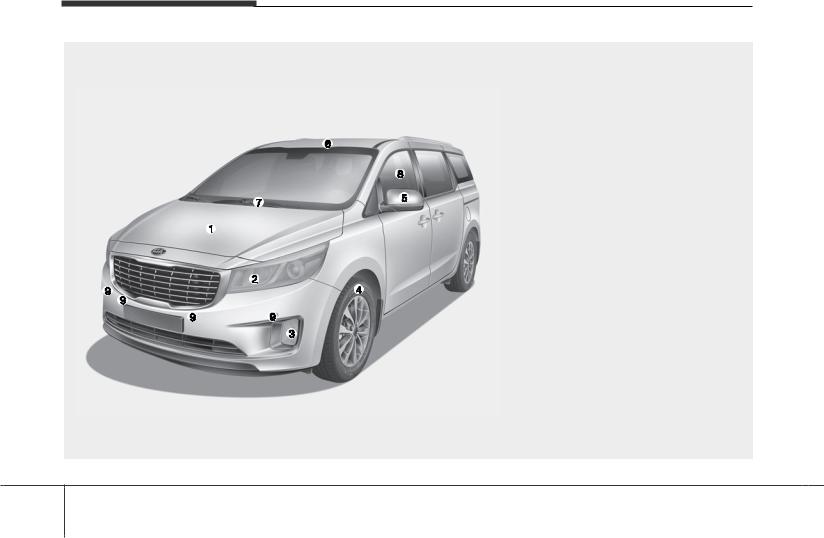
Your vehicle at a glance
EXTERIOR OVERVIEW
Front view
1. Hood...................................................... |
4-56 |
|
2. Head lamp.................................. |
4-132, 7-75 |
|
3. Fog lamp .................................... |
4-137, 7-75 |
|
4. Wheel and tire................................ |
7-49, 8-4 |
|
5. |
Outside rearview mirror......................... |
4-77 |
6. |
Sunroof.................................................. |
4-62 |
7. |
Front windshield wiper blades.... |
4-139, 7-43 |
8. Windows ................................................ |
4-51 |
|
9. |
Parking assist system ......................... |
4-125 |
The actual shape may differ from the illustration.
OYP014001K
2 2
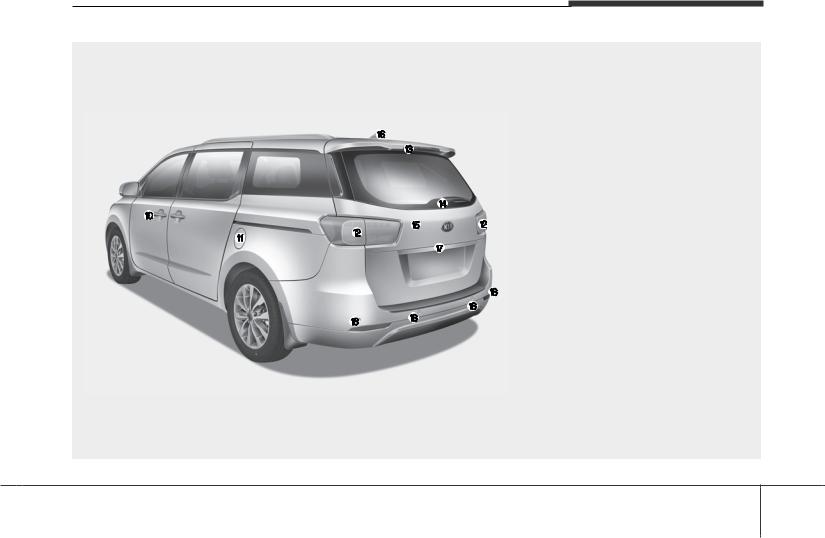
Your vehicle at a glance
Rear view
10. |
Door locks ........................................... |
4-25 |
11. |
Fuel filler lid ......................................... |
4-58 |
12. Rear combination lamp ....................... |
7-80 |
|
13. High mounted stop lamp ..................... |
7-83 |
|
14. Rear window wiper blade......... |
4-140, 7-44 |
|
15. Tailgate....................................... |
4-31, 4-42 |
|
16. Antenna ............................................. |
4-201 |
|
17. Rearview camera .............................. |
4-129 |
|
18. |
Parking assist system ............ |
4-121, 4-125 |
The actual shape may differ from the illustration.
OYP014002K
2 3
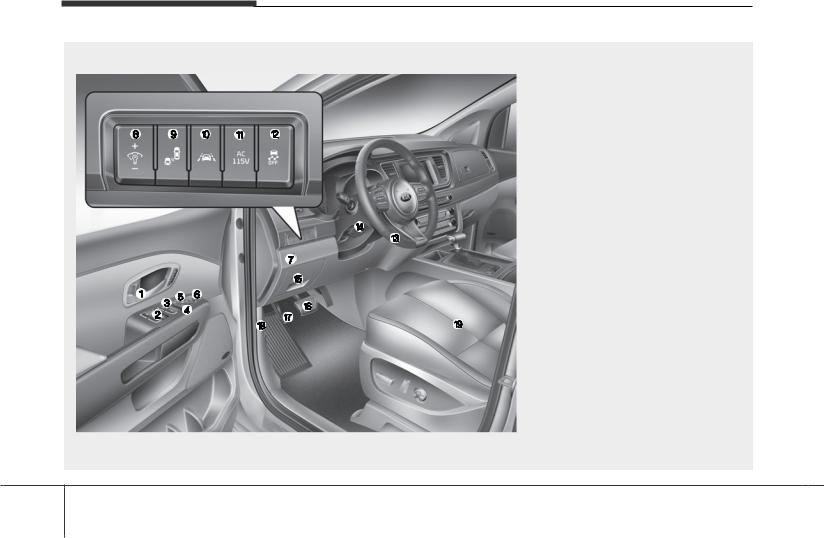
Your vehicle at a glance
INTERIOR OVERVIEW
1. Inside door handle................................... |
4-27 |
2. Power window switch............................... |
4-51 |
3. Central door lock switch .......................... |
4-28 |
4. Power window and rear sunroof |
|
lock button................................................ |
4-55 |
5. Outside rearview mirror control............... |
4-78 |
6. Outside rearview mirror folding switch .... |
4-79 |
7. Fuel filler lid open switch ......................... |
4-58 |
8. Instrument panel illumination |
|
control switch ........................................... |
4-83 |
9. BSD ON/OFF button ............................... |
5-70 |
10. LDWS ON/OFF button .......................... |
5-77 |
11. AC inverter button................................ |
4-193 |
12. ESC OFF button.................................... |
5-25 |
13. Steering wheel....................................... |
4-67 |
14. Tilt and telescopic steering |
|
control lever ........................................... |
4-68 |
15. Inner panel fuse panel........................... |
7-65 |
16. Brake pedal............................................ |
5-19 |
17. Parking brake pedal............................... |
5-21 |
18. Hood release lever................................. |
4-56 |
19. Seat.......................................................... |
3-2 |
The actual interior in the vehicle may differ from the illustration
OYP016003N
2 4
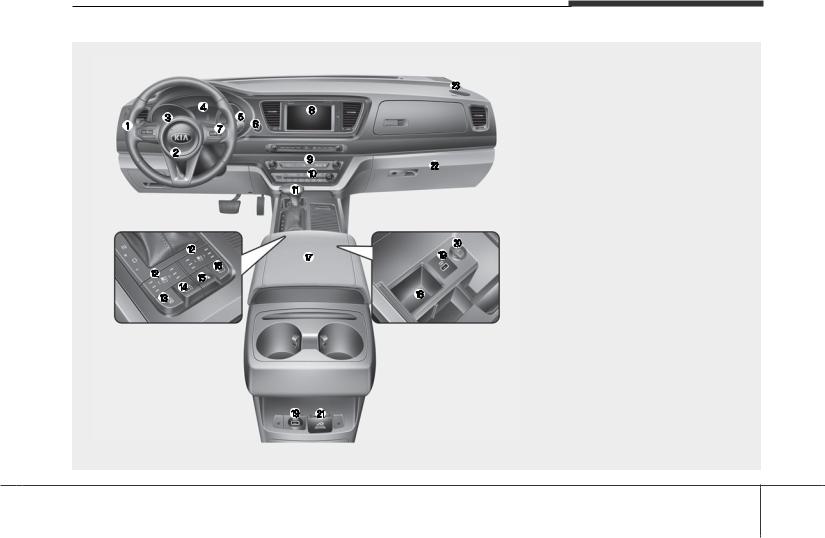
INSTRUMENT PANEL OVERVIEW
The actual instrument panel in the vehicle may differ from the illustration
Your vehicle at a glance
1. Audio remote control buttons |
............ |
4-209 |
2. Driver’s front air bag ............................ |
|
3-73 |
3. Horn..................................................... |
|
4-70 |
4. Instrument cluster................................ |
|
4-82 |
5. Wiper and washer control lever......... |
4-138 |
|
6. Ignition switch........................................ |
|
5-6 |
Engine START/STOP button ................. |
|
5-9 |
7. Cruise control button ........................... |
|
5-46 |
Smart cruise control button ................. |
|
5-50 |
8. Audio ................................................. |
|
4-206 |
9. Hazard warning flasher ......................... |
|
6-2 |
10. Climate control system......... |
4 - 146, 4-162 |
|
11. Shift lever........................................... |
|
5-13 |
12. Seat warmer .................................... |
|
4-190 |
Seat cooler ...................................... |
|
4-191 |
13. Steering wheel warmer |
|
|
ON/OFF Button ................................. |
|
4-69 |
14. Active ECO button............................. |
|
5-66 |
Drive mode button ............................. |
|
5-67 |
15. Parking assist system |
|
|
ON/OFF button................................ |
|
4-125 |
16. 360° Camera monitoring system |
|
|
ON/OFF button................................ |
|
4-130 |
17. Center console storage box ............ |
|
4-187 |
18. Sunglasses holder........................... |
|
4-188 |
19. USB charger.................................... |
|
4-195 |
20. Power outlet..................................... |
|
4-192 |
21. AC inverter ...................................... |
|
4-193 |
22. Glove box ........................................ |
|
4-188 |
23. Passenger's front air bag .................. |
|
3-73 |
OYP016004N
2 5
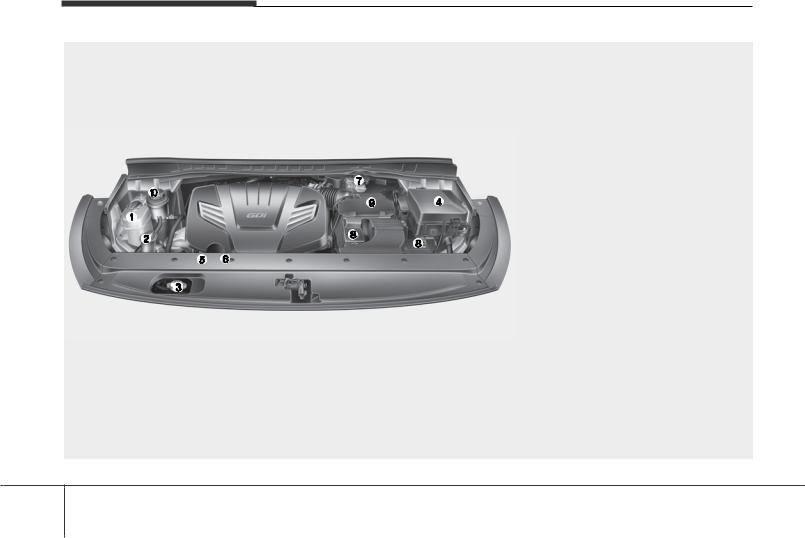
Your vehicle at a glance
ENGINE COMPARTMENT
■ Gasoline Engine (Lambda 3.3L)
1. |
Engine coolant reservoir................... |
7-33 |
2. Windshield washer fluid reservoir ..... |
7-37 |
|
3. |
Radiator cap ..................................... |
7-34 |
4. Fuse box ........................................... |
7-66 |
|
5. |
Engine oil filler cap ........................... |
7-30 |
6. |
Engine oil dipstick ............................. |
7-30 |
7. |
Brake fluid reservoir.......................... |
7-35 |
8. |
Battery terminal ................................ |
7-46 |
9. |
Air cleaner......................................... |
7-38 |
10.Power steering fluid(if equipped) ..... |
7-36 |
|
The actual engine compartment in the vehicle may differ from the illustration.
OYP074061N
2 6
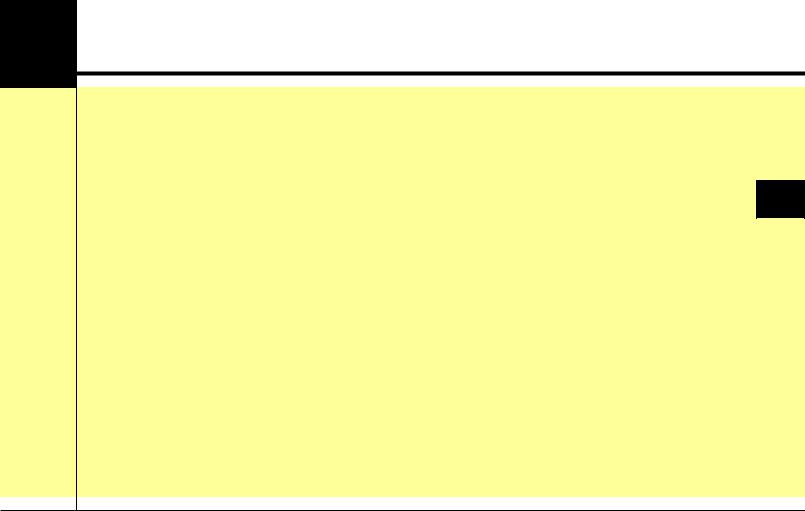
Safety features of your vehicle
Seats . . . . . . . . . . . . . . . . . . . . . . . . . . . . . . . . . . . . . . 3-2
• Front seat adjustment - manual. . . . . . . . . . . . . . . . . . 3-6
• Front seat adjustment - power. . . . . . . . . . . . . . . . . . . 3-8
• Driver position memory system (for power seat). . . 3-10
• Headrest (for front seat) . . . . . . . . . . . . . . . . . . . . . . . 3-12
• Seatback pocket . . . . . . . . . . . . . . . . . . . . . . . . . . . . . . 3-15
• Rear seat adjustment . . . . . . . . . . . . . . . . . . . . . . . . . 3-16
• Headrest (for rear seat). . . . . . . . . . . . . . . . . . . . . . . . 3-30
Seat belts . . . . . . . . . . . . . . . . . . . . . . . . . . . . . . . . . 3-34
• Seat belt restraint system . . . . . . . . . . . . . . . . . . . . . . 3-34
• Pre-tensioner seat belt . . . . . . . . . . . . . . . . . . . . . . . . 3-45
• Seat belt precautions . . . . . . . . . . . . . . . . . . . . . . . . . . 3-47
• Care of seat belts . . . . . . . . . . . . . . . . . . . . . . . . . . . . . 3-50
Child restraint system . . . . . . . . . . . . . . . . . . . . . . 3-51
• Using a child restraint system . . . . . . . . . . . . . . . . . . 3-52
• Tether anchor system . . . . . . . . . . . . . . . . . . . . . . . . . 3-56
• Lower anchor system . . . . . . . . . . . . . . . . . . . . . . . . . 3-57
Air bag
- advanced supplemental restraint system. . . . . 3-59
• How does the air bag system operate . . . . . . . . . . . . 3-60
• Air bag warning light . . . . . . . . . . . . . . . . . . . . . . . . . 3-62
• SRS components and functions . . . . . . . . . . . . . . . . . 3-63
• Occupant Detection System(ODS). . . . . . . . . . . . . . . 3-66
• Driver's and passenger's front air bag . . . . . . . . . . . 3-73 3
• Side air bag . . . . . . . . . . . . . . . . . . . . . . . . . . . . . . . . . 3-76
• Curtain air bag . . . . . . . . . . . . . . . . . . . . . . . . . . . . . . 3-78
• SRS Care . . . . . . . . . . . . . . . . . . . . . . . . . . . . . . . . . . . 3-85
• Air bag warning label . . . . . . . . . . . . . . . . . . . . . . . . . 3-86
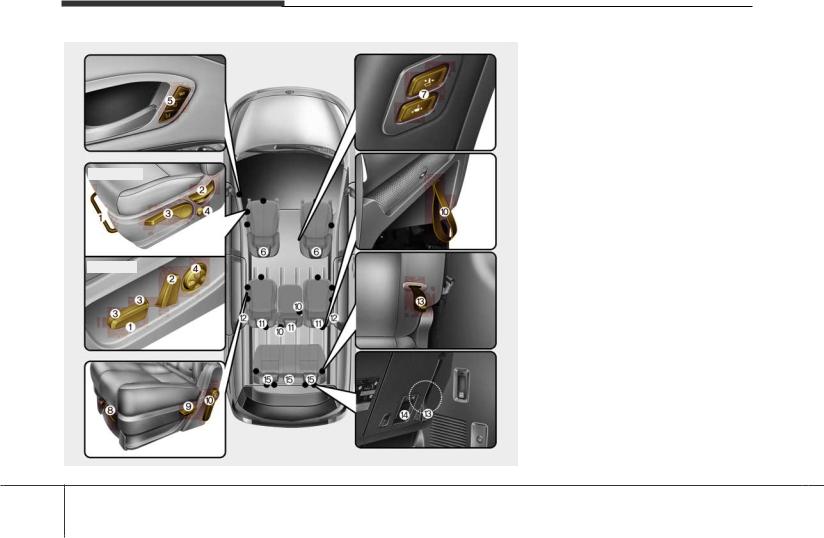
Safety features of your vehicle
SEATS
Manual seat
Power seat
Front seat
(1)Forward and backward
(2)Seatback angle
(3)Seat cushion height
(4)Lumbar support (Driver’s seat)
(5)Driver position memory
(6)Headrest
(7)Walk-in switch
2nd / 3rd row seat
(8)Forward and backward
(9)Seatback angle and folding
(10)Walk-in
(11)Headrest
(12)Armrest
(13)Seatback angle and folding
(14)Seat sinking
(15)Headrest
OYP037322N
3 2
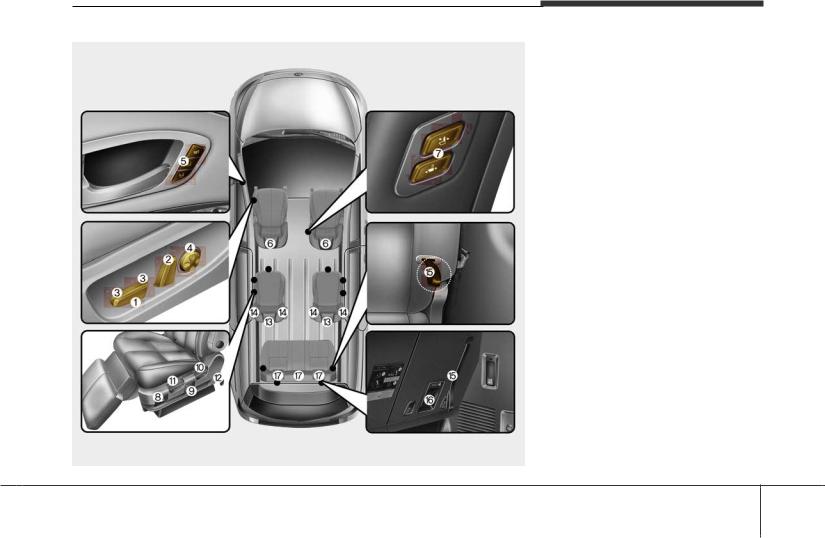
Safety features of your vehicle
■ For SXL package
OYP036297N
Front seat
(1)Forward and backward
(2)Seatback angle
(3)Seat cushion height
(4)Lumbar support (Driver’s seat)
(5)Driver position memory
(6)Headrest
(7)Walk-in switch
2nd / 3rd row seat
(8)Forward and backward
(9)Left and right
(10)Seatback angle and folding
(11)Leg support
(12)Walk-in
(13)Headrest
(14)Armrest
(15)Seatback angle and folding
(16)Seat sinking
(17)Headrest
3 3
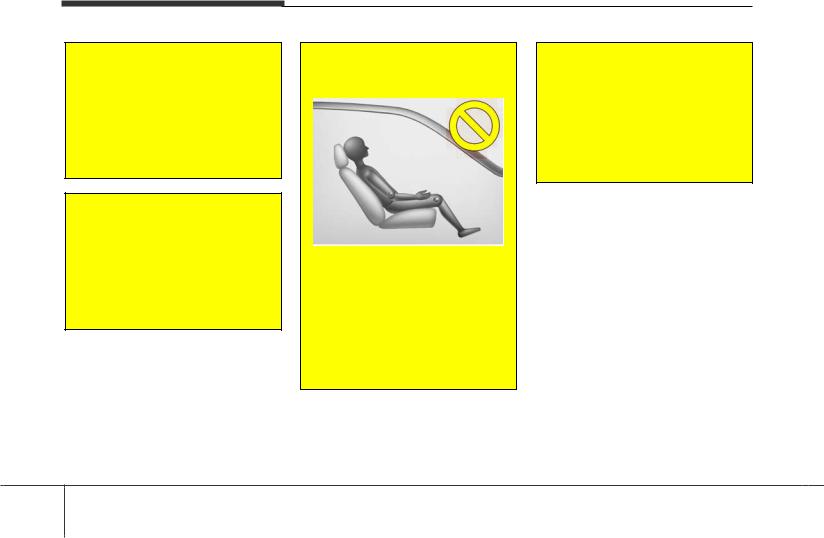
Safety features of your vehicle
WARNING - Loose objects
Do not place anything in the driver's foot well or under the front seats. Loose objects in the driver's foot area could interfere with the operation of the foot pedals.
WARNING - Uprighting seat
Do not press the release lever on a manual seatback without holding and controlling the seatback. The seatback will spring upright possibly impacting you or other passengers.
WARNING - Driver responsibility for passengers
1KMN3662
The driver must advise the passenger to keep the seatback in an upright position whenever the vehicle is in motion. If a seat is reclined during an accident, the occupant's hips may slide under the lap portion of the seat belt, applying great force to the unprotected abdomen.
WARNING - Seat cushion
Occupants should never sit on aftermarket seat cushions or sitting cushions.
The passenger's hips may slide under the lap portion of the seat belt during an accident or a sudden stop.
3 4
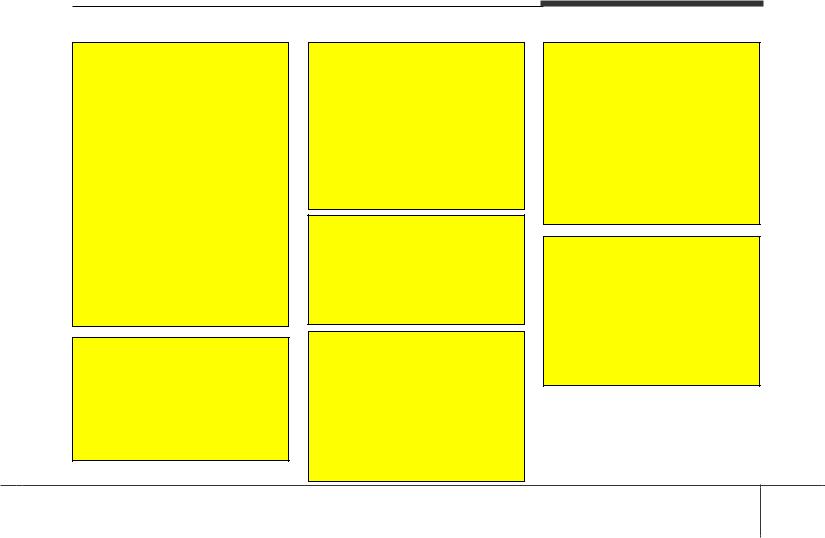
WARNING - Driver’s seat
•Never attempt to adjust the seat while the vehicle is moving. This could result in loss of control of your vehicle.
•Do not allow anything to interfere with the normal position of the seatback and seatback adjustment.
•Sit as far back as possible from the steering wheel while still maintaining comfortable control of the your vehicle. A distance of at least 10" from your chest to the steering wheel is recommended. Failure to do so can result in air bag inflation injuries to the driver.
WARNING - Rear seatbacks
Always lock the rear seatback before driving. Failure to do so could result in passengers or objects being thrown forward injuring vehicle occupants.
WARNING - Luggage and Cargo
Do not stack pile or stack luggage or cargo higher than the seatback in the cargo area. In an accident the cargo could strike and injury a passenger. If objects are large, heavy or must be piled, they must be secured in the cargo area.
WARNING - Cargo Area
Do not allow passengers to ride in the cargo area under any circumstance. The cargo area is solely for the purpose of transporting luggage or cargo.
WARNING - Unexpected Seat Movement
After adjusting a manual seat, always check that it is locked by shifting your weight to the front and back. Sudden or unexpected movement of the driver's seat could cause you to lose control of the vehicle.
Safety features of your vehicle
WARNING - Seat
adjustment
•Do not adjust the seat while wearing seat belts. Moving the seat forward will cause strong pressure on the abdomen.
•Do not place your hand near the seat bottom or seat track while adjusting the seat. Your hand could get caught in the seat mechanism.
WARNING - Small Objects
Use extreme caution when picking small objects trapped under the seats or between the seat and the center console. Your hands might be cut or injured by the sharp edges of the seats mechanism.
3 5
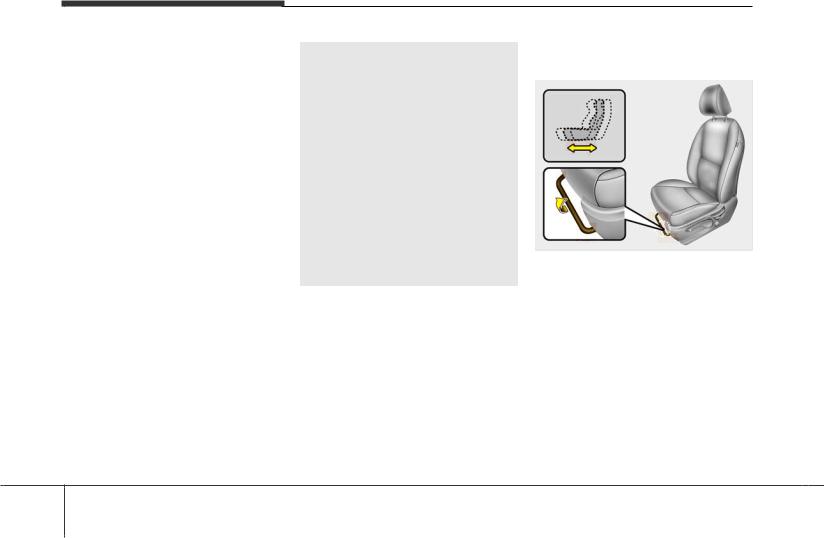
Safety features of your vehicle
Feature of Seat Leather
•Leather is made from the outer skin of an animal, which goes through a special process to be available for use. Since it is a natural substance, each part differs in thickness or density.
Wrinkles may appear as a natural result of stretching and shrinking depending on the temperature and humidity.
•The seat is made of stretchable fabric to improve comfort.
•The parts contacting the body are curved and the side supporting area is high which provides driving comfort and stability.
•Wrinkles may appear naturally from usage. It is not a fault of the product.
CAUTION
•Wrinkles or abrasions which appear naturally from usage are not covered by warranty.
•Belts with metallic accessories, zippers or keys inside the back pocket may damage the seat fabric.
•Make sure not to wet the seat. It may change the nature of natural leather.
•Jeans or clothes which could bleach may contaminate the surface of the seat covering fabric.
Front seat adjustment - manual
Forward and backward
OYP034002
To move the seat forward or backward :
1.Pull the seat slide adjustment lever up and hold it.
2.Slide the seat to the position you desire.
3.Release the lever and make sure the seat is locked in place.
Adjust the seat before driving, and make sure the seat is locked securely by trying to move forward and backward without using the lever. If the seat moves, it is not locked properly.
3 6
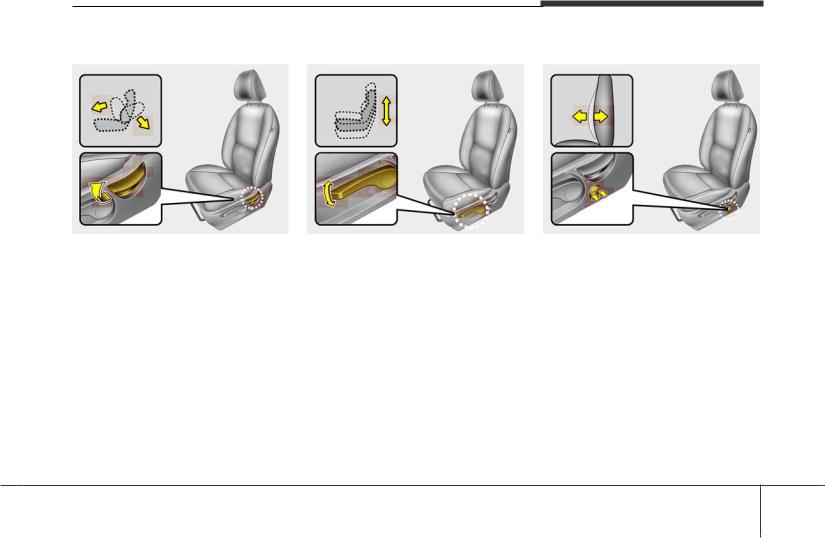
Seatback angle
OYP034003
To recline the seatback :
1.Lean forward slightly and lift up the seatback recline lever.
2.Carefully lean back on the seat and adjust the seatback of the seat to the position you desire.
3.Release the lever and make sure the seatback is locked in place. (The lever MUST return to its original position for the seatback to lock.)
Seat height (for driver’s seat)
OYP034004
To change the height of the seat, push the lever upwards or downwards.
•To lower the seat cushion, push the lever down several times.
•To raise the seat cushion, pull the lever up several times.
Safety features of your vehicle
Lumbar support (if equipped)
OYP034005
The lumbar support can be adjusted by pressing the lumbar support switch on the side of the seat.
1.Press the front portion of the switch to increase support, or the rear portion of the switch, to decrease support.
2.Release the switch once it reaches the desired position.
3 7
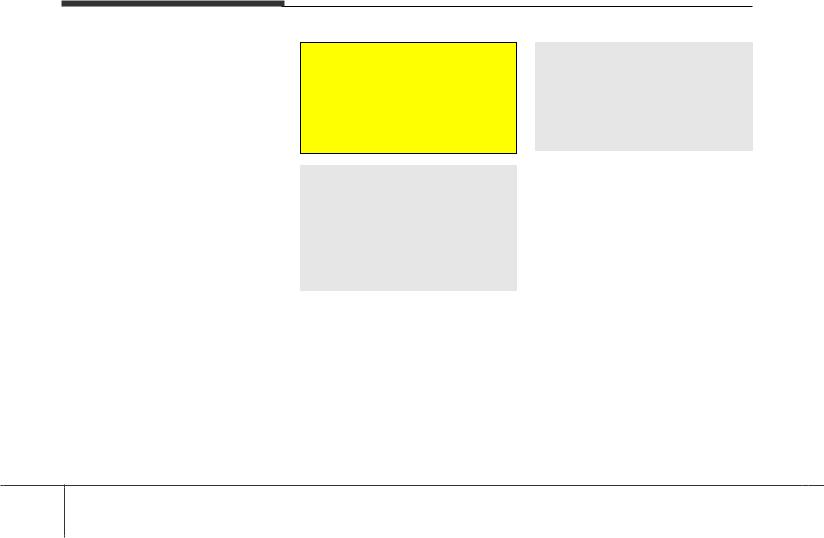
Safety features of your vehicle
Front seat adjustment - power (if equipped)
The front seat can be adjusted by using the control switches located on the outside of the seat cushion. Before driving, adjust the seat to the proper position so you can easily control the steering wheel, pedals and switches on the instrument panel.
WARNING - Unattended children
Do not leave children unattended in the vehicle. Children might operate features of the vehicle that could injure them.
CAUTION - Power seat adjustments
The power seating controls function by electronic motor.
Excessive operation may cause damage to the electrical equipment.
CAUTION - Power Seating
Do not operate two or more power seat control switches at the same time. Doing so may damage the power seat motor or electrical components.
When in operation, the power seatconsumes a large amount of electrical power. To prevent unnecessary charging system drain, don’t adjust the power seat longer than necessary while the engine is not running.
3 8
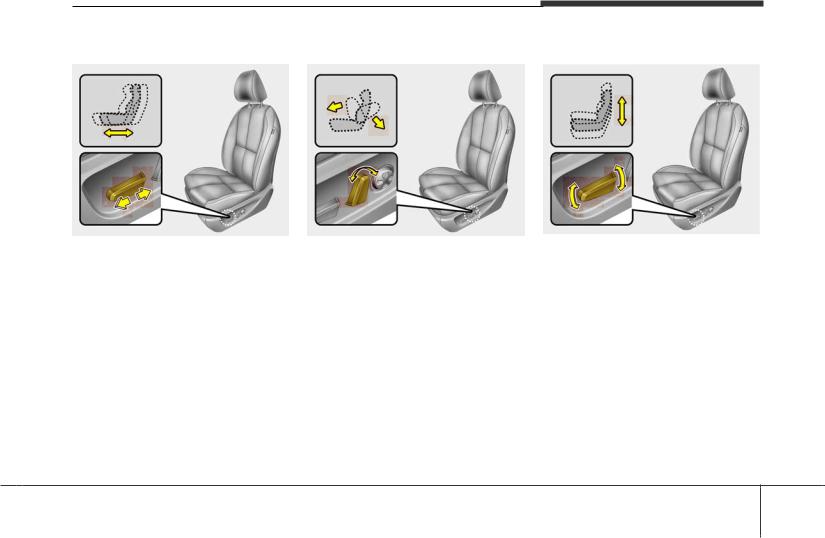
Safety features of your vehicle
Forward and backward |
Seatback angle |
Seat height (if equipped) |
OYP034006N
Push the control switch forward or backward to move the seat to the desired position. Release the switch once the seat reaches the desired position.
OYP034007N
Push the control switch forward or backward to move the seatback to the desired angle. Release the switch once the seat reaches the desired position.
OYP034008N
Pull the front portion of the control switch up to raise or press down to lower the front part of the seat cushion. Pull the rear portion of the control switch up to raise or press down to lower the rear part of the seat cushion. Release the switch once the seat reaches the desired position.
3 9
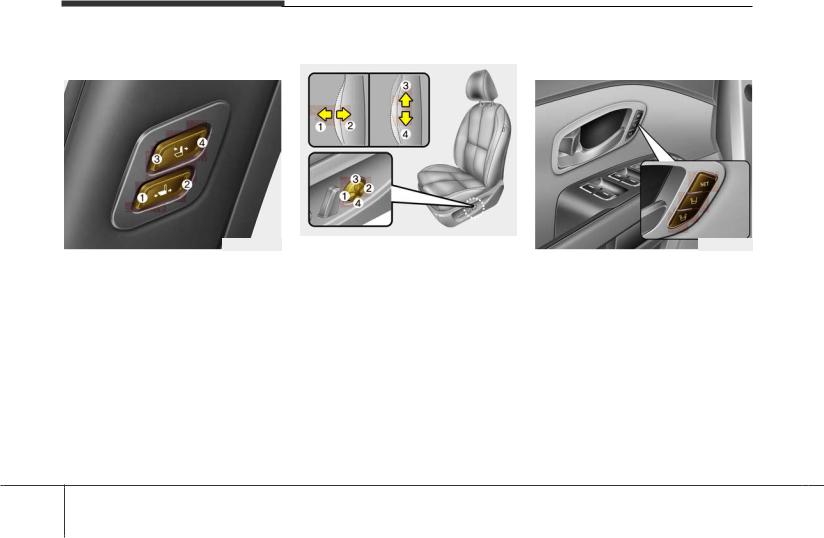
Safety features of your vehicle
Walk-in Seat (for front passenger |
Lumbar support (for driver’s seat) Driver position memory system |
seat, if equipped) |
(if equipped, for power seat) |
OUM036096L
The switch is located on the left side of the front passenger’s seatback.
To adjust the position of front passenger’s seat ;
Press the control switch forward (1) or rearward (2)to move the seat to the desired position.
Press the control switch forward (3) or rearward (4) to move the seatback to the desired angle.
Do not use these switches while the front passenger seat is occupied.
OYP034009N
The lumbar support can be adjusted by pressing the lumbar support switch on the side of the drivers seat. Press the front portion of the switch (1) to increase support, or the rear portion of the switch (2) to decrease support.
Move the support position up and down by pressing the switch (3) or (4).
OYP034025
A driver position memory system is provided to store and recall the driver seat and outside rearview mirror position with a simple button operation. By saving the desired position into the system memory, different drivers can reposition the driver seat based upon their driving preference. If the battery is disconnected, the desired seat position memory will need to be re-saved.
3 10
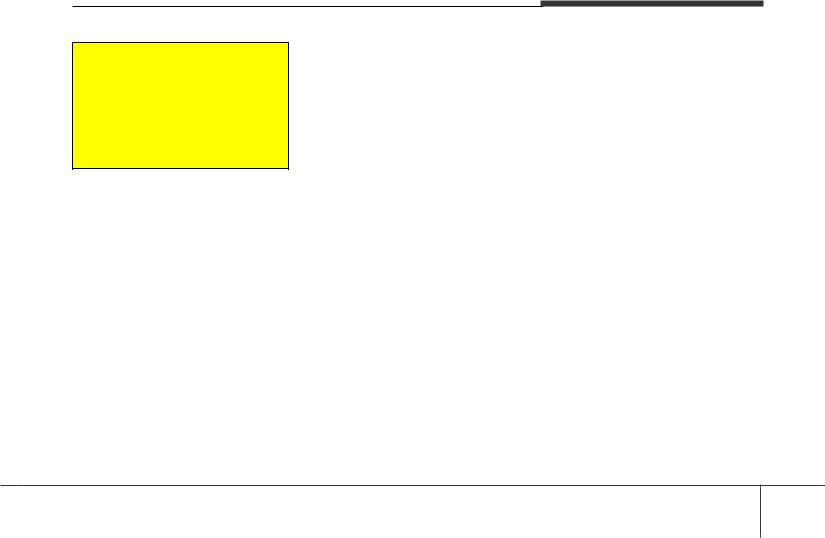
WARNING
Never attempt to operate the driver position memory system while the vehicle is moving.
This could result in loss of control, and an accident causing death, serious injury.
Safety features of your vehicle
Storing positions into memory using the buttons on the door
Storing driver’s seat positions
1.Shift the shift lever into P while the engine start/stop button is ON or ignition switch ON.
2.Adjust the driver’s seat and outside rearview mirror comfortable for the driver.
3.Press SET button on the control panel. The system will beep once.
4.Press one of the memory buttons (1 or 2) within 5 seconds after pressing the SET button. The system will beep twice when memory has been successfully stored.
NOTICE
When recalling an adjustment memory button while sitting in the vehicle, you can be surprised by the setting chosen if the memory has been adjusted by someone else. If that occurs, immediately push the seat position control knob in the direction of the desired position to stop further undesired movement.
Recalling positions from memory
1.Shift the shift lever into P while the engine start/stop button is ON or ignition switch ON.
2.To recall the position in the memory, press the desired memory button (1 or 2). The system will beep once, then the driver’s seat will automatically adjust to the stored position.
Adjusting the control switch for the driver’s seat while the system is recalling the stored position will cause the movement to stop and move in the direction that the control switch is moved.
3 11
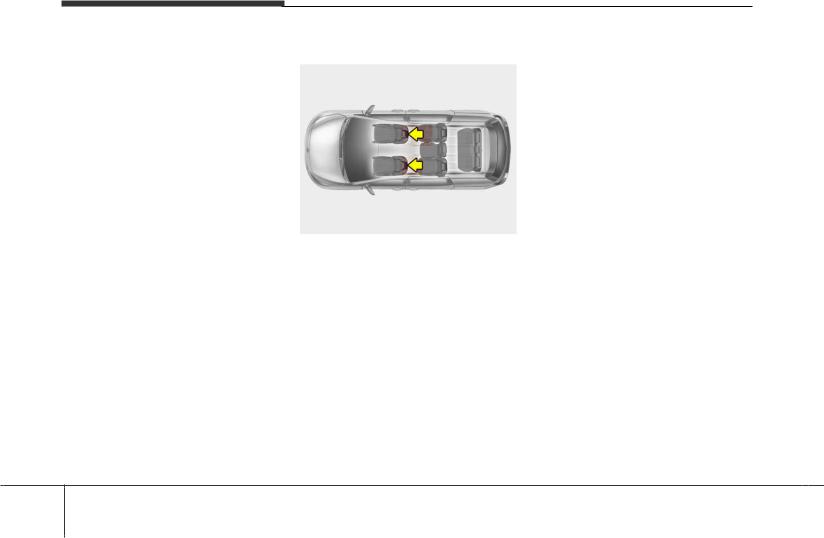
Safety features of your vehicle
Easy access function (if equipped)
The system will move the driver's seat automatically as follows :
•Without smart key system
-It will move the driver’s seat rearward when the ignition key is removed.
-It will move the driver’s seat forward when the ignition key is inserted.
•With smart key system
-It will move the driver’s seat rearward when the engine start/stop button is changed to the OFF position.
-It will move the driver’s seat forward when the engine start/stop button is changed to the ACC or START position.
You can activate or deactivate this feature. Refer to "User settings" in chapter 4.
Headrest (for front seat)
OYP034285N
The driver's and front passenger's seats are equipped with a headrest for the occupant's safety and comfort.
The headrest not only provides comfort for the driver and front passenger, but also helps protect the head and neck in the event of a rear collision.
For maximum effectiveness in case of an accident, the headrest should be adjusted so the middle of the headrest is at the same height of the center of gravity of an occupant's head. Generally, the center of gravity of most people's head is similar with the height of the top of their eyes. Also, adjust the headrest as close to your head as possible. For this reason, the use of a cushion that holds the body away from the seatback is not recommended.
3 12
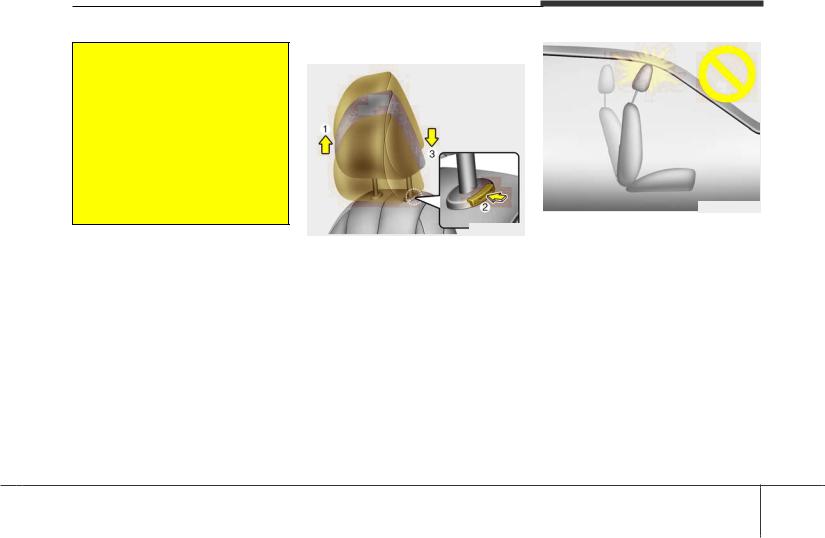
WARNING - Headrest
removal/adjustment
•Do not operate the vehicle with the headrests removed. Headrests can provide critical neck and head support in a crash.
•Do not adjust the headrest height while the vehicle is in motion. Driver may lose control of the vehicle.
Safety features of your vehicle
Adjusting the height up and down
OYP034010
To raise the headrest, pull it up to the desired position (1). To lower the headrest, push and hold the release button (2) on the headrest support and lower the headrest to the desired position (3).
OYFH034205
NOTICE
If you recline the seatback towards the front with the headrest and seat cushion raised, the headrest may come in contact with the sunvisor or other parts of the vehicle.
3 13
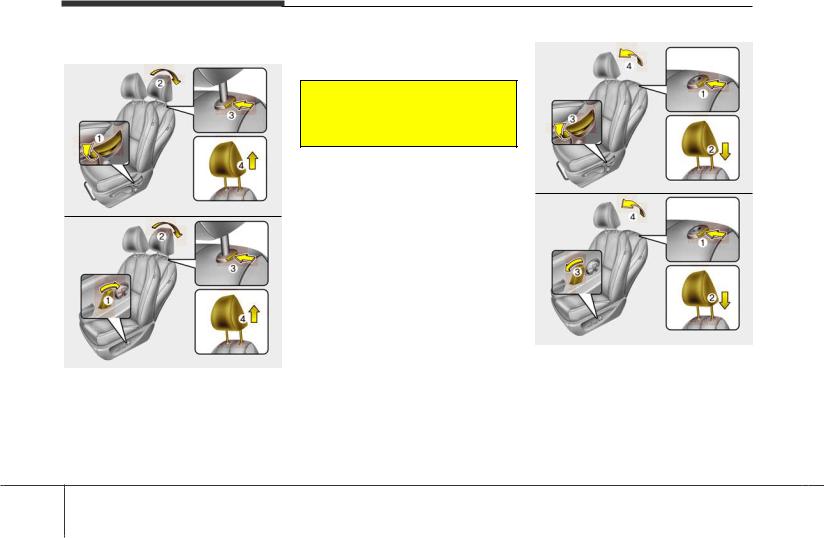
Safety features of your vehicle
Removal and reinstallation
■ Type A
OYP034012
■ Type B
OYP034013N
To remove the headrest :
1.Recline the seatback (2) with the recline lever or switch (1).
2.Raise headrest as far as it can go.
3.Press the headrest release button
(3) while pulling the headrest up (4).
WARNING
NEVER allow anyone to ride in a seat with the headrest removed.
■ Type A
OYP034014
■ Type B
OYP034015N
To reinstall the headrest :
1.Put the headrest poles (2) into the holes while pressing the release button (1).
2.Recline the seatback (4) with the recline lever or switch (3).
3 14
